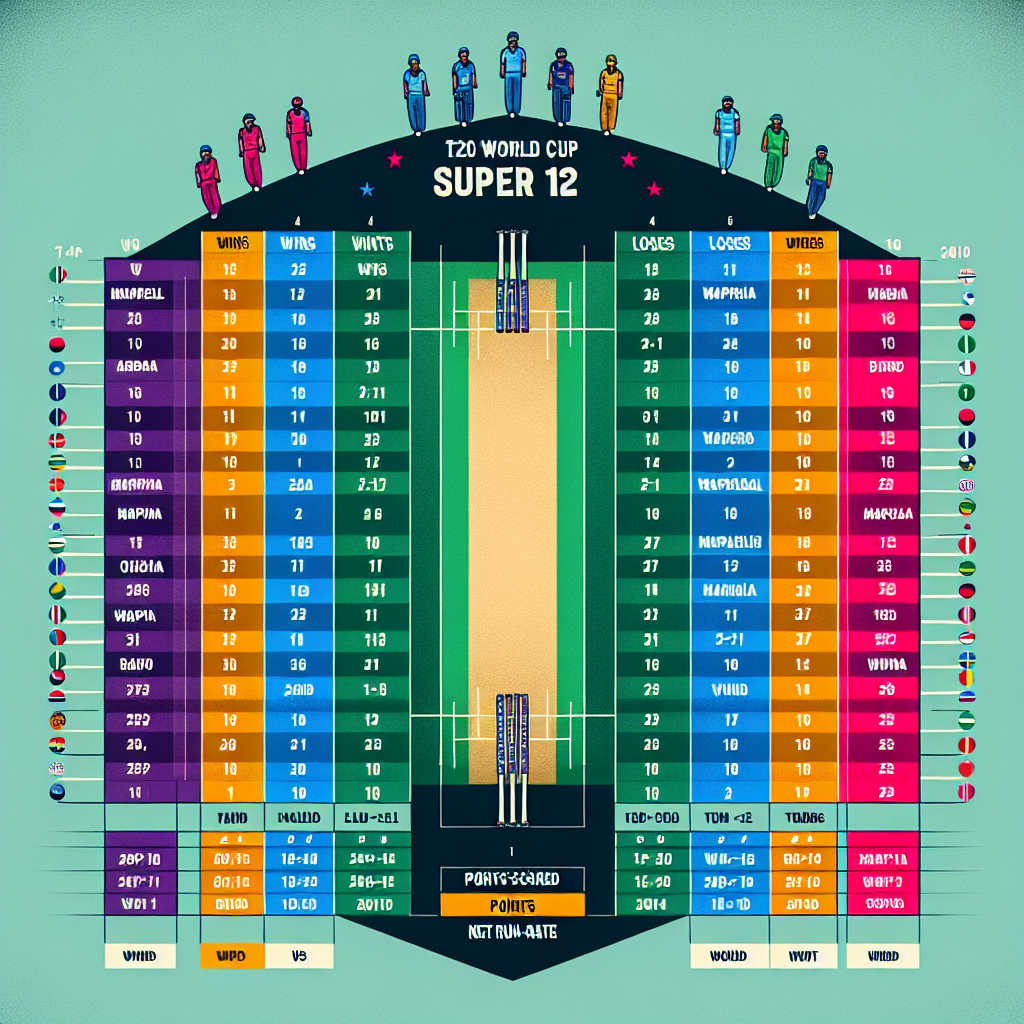
The T20 World Cup is one of the most exhilarating events in the cricketing calendar, bringing together the best teams from around the globe to compete in the shortest and most dynamic format of the game. The Super 12 stage is a critical phase in the tournament, where the top teams battle it out for a place in the semi-finals. Understanding the points table during this stage is crucial for fans and analysts alike, as it provides insights into team performances and potential outcomes. This article delves into the intricacies of the T20 World Cup Super 12 points table, offering a detailed analysis of its structure, significance, and impact on the tournament.
Understanding the Super 12 Stage
The Super 12 stage is the second phase of the T20 World Cup, following the initial group stage. It features the top eight teams from the ICC T20I rankings, along with four teams that qualify from the preliminary round. These 12 teams are divided into two groups of six, and each team plays the others in its group once. The top two teams from each group advance to the semi-finals.
Structure of the Points Table
The points table is a dynamic and essential component of the Super 12 stage. It is structured to reflect the performance of each team based on several criteria:
- Points (Pts): Teams earn two points for a win, one point for a no-result or tie, and no points for a loss.
- Net Run Rate (NRR): This is a crucial tiebreaker used when teams have equal points. It is calculated based on the runs scored and conceded per over.
- Wins (W) and Losses (L): The number of matches won and lost by each team.
- Matches Played (M): The total number of matches each team has played.
Significance of the Points Table
The points table serves as a barometer for team performance and is pivotal in determining which teams progress to the knockout stages. It provides a snapshot of the tournament's competitive landscape and helps fans and analysts gauge the form and consistency of each team.
Impact on Team Strategies
The points table influences team strategies in several ways:
- Match Approach: Teams may adopt aggressive or conservative strategies based on their position in the table. For instance, a team needing a significant boost in NRR might play more aggressively to secure a big win.
- Player Selection: Teams might rotate players to manage workloads or exploit specific matchups, especially if they have already secured a semi-final spot.
- Psychological Edge: A strong position in the points table can boost team morale, while a poor standing might necessitate a change in approach to regain momentum.
Case Studies: Memorable Super 12 Performances
Throughout the history of the T20 World Cup, several teams have delivered memorable performances during the Super 12 stage. These case studies highlight the importance of the points table in shaping tournament narratives.
India's Dominance in 2007
In the inaugural T20 World Cup in 2007, India showcased exceptional performance during the Super 12 stage. Despite being underdogs, they topped their group, thanks to consistent performances and strategic brilliance. Their ability to win crucial matches and maintain a healthy NRR was instrumental in their journey to becoming champions.
West Indies' Resurgence in 2016
The West Indies' campaign in the 2016 T20 World Cup is another example of a team leveraging the points table to their advantage. After a shaky start, they bounced back with decisive victories, securing their place in the semi-finals. Their strategic use of power hitters and effective bowling helped them maintain a strong NRR, ultimately leading to their second T20 World Cup title.
Statistics and Trends
Analyzing statistics from past T20 World Cups provides valuable insights into trends and patterns that can influence future tournaments.
Winning Margins and NRR
Historically, teams with a higher NRR have a better chance of advancing to the semi-finals, especially in tightly contested groups. For instance, in the 2014 T20 World Cup, South Africa's superior NRR helped them edge out New Zealand for a semi-final spot, despite both teams having the same number of points.
Impact of Rain-affected Matches
Rain-affected matches can significantly impact the points table, as they often result in shared points. This can benefit teams struggling for form, but it can also disrupt the momentum of in-form teams. The 2012 T20 World Cup saw several rain-affected matches, leading to unexpected shifts in the points table dynamics.
Conclusion: The Crucial Role of the Points Table
The T20 World Cup Super 12 points table is more than just a record of wins and losses; it is a strategic tool that shapes the tournament's narrative. By understanding its structure and significance, fans and analysts can gain deeper insights into team performances and potential outcomes. The points table not only reflects the competitive spirit of the tournament but also influences team strategies and decision-making processes. As the T20 World Cup continues to evolve, the points table will remain a vital component in determining the champions of this thrilling format.
In summary, the Super 12 points table is a dynamic and essential element of the T20 World Cup, providing a clear picture of team standings and influencing the course of the tournament. By analyzing past performances and trends, we can appreciate the strategic depth and excitement that this stage brings to the world of cricket.

